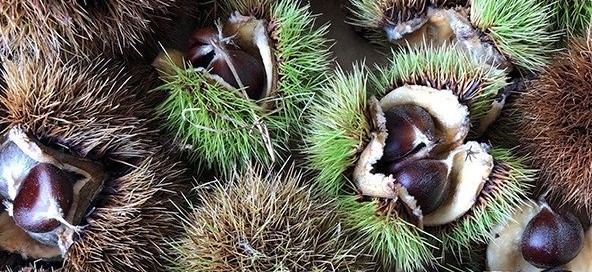The State We're In
Using science to bring back iconic American chestnut trees
“Chestnuts roasting on an open fire, Jack Frost nipping at your nose …” By the time those famous lyrics were penned in 1945, most of the magnificent American chestnut forest in the eastern United States were gone, the victims of a blight that would eventually kill some four billion trees.
In today’s terms, it would be a pandemic … one far more deadly to American chestnuts than COVID-19 to humans.
More than a century after the majority of American chestnut trees were wiped out, those who love the iconic species are hoping that modern science and technology – including genetic engineering and biological controls – will bring them back.
“We’re talking decades and centuries to restore a species,” said Sara Fitzsimmons, director of restoration for the American Chestnut Foundation, a North Carolina-based nonprofit working on a chestnut comeback. “It’s going to be a long slog, and we’re going to need a lot of people planting trees.”
For thousands of years, the American chestnut (Castanea dentata) dominated Eastern forests – including those in New Jersey – growing upward of 100 feet tall, with trunks as wide as 10 feet in diameter. Each fall the trees’ sweet nuts reliably blanketed forest floors, providing a bountiful harvest for wildlife and people. The straight-grained, rot-resistant trunks were used to make timber for everything from houses to railroad ties. Entire economies and ecosystems centered around American chestnuts.
The beginning of the end came in the late 1800s, when Asian chestnut trees carrying a microscopic fungus were imported to nurseries in the United States. American chestnuts had no resistance to the fungus, which caused cankers that girdled the bark and killed trees. The chestnut blight, first discovered in 1904 at the Bronx Zoo in New York, steadily spread across the great chestnut forests, destroying nearly every tree in its path.
“The loss of the American chestnut was an American tragedy, described by an ecologist as the worst environmental disaster ever to strike our country,” said Rex Mann, a retired forest ranger who now volunteers with the American Chestnut Foundation, in the 2019 documentary “The Chestnut Tree: Bringing Back an American Icon.”
But thanks to science, a comeback for American chestnuts is now possible. The American Chestnut Foundation is seeking to restore the tree to its native range using a three-pronged strategy it calls “3BUR: Breeding, Biotechnology and Biocontrol United for Restoration.”
- Breeding – For over three decades, the Foundation has been cross-breeding American chestnut trees with Chinese chestnuts, hoping to create a blight-resistant hybrid with the best traits of the original American chestnut. Four tree generations into the program, the traditional breeding program has produced a genetically diverse population of hybrids with improved blight tolerance … although they’re still trying for improvement. Breeding is carried out at a research farm in Virginia and at more than 500 plots throughout the tree’s native range, including several in New Jersey.
- Biotechnology – The American Chestnut Foundation is also using genetic engineering. Scientists at the State University of New York discovered that a gene from wheat produces an enzyme, oxalate oxidase, which enhances the tree’s tolerance to the blight. In October, the college petitioned the U.S. Department of Agriculture to grant non-regulated status to a genetically engineered American chestnut tree known as Darling 58. If approved, Darling 58 would be the first genetically engineered tree allowed to be planted in the wild in the United States. “We won’t know for a year or two, maybe longer,” says Fitzsimmons.
- Biocontrol – The primary biological control method being explored by the American Chestnut Foundation and its partners is called “hypovirulence,” or using a virus to reduce the blight’s ability to cause lethal infections in the trees. Fitzsimmons said research is being done at several places in Monmouth County, including Hartshorne Woods Park, where a virus is attacking the fungus on American chestnut trees planted after the great blight.
“None of these three B’s can restore a species in isolation,” noted Fitzsimmons. But used together, they may be able to bring back the American chestnut.
During a time when many American forests are under stress from invasive insects, invasive non-native plants, diseases, over-abundant deer and climate change, the success of the 3BUR program has implications beyond American chestnut trees.
“It’s not just about the chestnut right now,” said Fitzsimmons. “We’re setting a template for the restoration of other native species. Yes, there’s reason to restore the American chestnut on its own. But there are a lot of other species that will need restoration.”
This holiday season, you can still enjoy chestnuts roasting on an open fire – but they will be nuts imported from Europe. If restoration efforts go well, perhaps future generations will be able to roast plentiful American chestnuts again!
To learn more about American chestnut restoration efforts, visit the American Chestnut Foundation website at https://acf.org/. One especially helpful resource is a series of online video conferences, known as “Chestnut Chats,” that took place this past year.
To watch the documentary “The Chestnut Tree: Bringing Back an American Icon,” go to https://www.youtube.com/watch?v=-mhMdUryolU&feature=youtu.be.
And for information about preserving New Jersey’s land and natural resources – including forests where American chestnuts could be restored – visit the New Jersey Conservation Foundation website at www.njconservation.org or contact me at info@njconservation.org.
About the Authors
Alison Mitchell
Co-Executive Director
John S. Watson, Jr.
Co-Executive Director
Tom Gilbert
Co-Executive Director, 2022-2023
Michele S. Byers
Executive Director, 1999-2021
View their full bios here.
Filter
Get The Latest News
From The Garden State
In the
News

